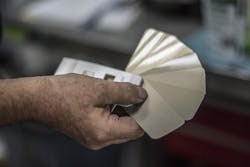When asked about the importance of color matching, Steve Jones doesn’t miss a beat:
“If I’m doing the sprayouts properly and checking my colors, I’m only painting cars one at a time,” he says. “Ninety-nine percent of your repaints are for color. If you’re repeating, that’s twice as much material you’re not getting paid for. That’s going to affect your bottom line, your efficiency, your paint and material numbers.” And if anything is living proof of improving your bottom line, it’s Jones’ detailed, stringent color matching process, which helped Premier Collision Center in Duluth, Ga., drop its paint and materials bill by $5,000 per month since he joined over a year ago. As the lead (and only) painter in the shop’s paint department, Jones helps maintain P&M gross profits at roughly 55 percent.
While painters often discuss best color practices, Tom Spencer—national account manager for Sherwin-Williams—who’s worked on color verification and mapping with hundreds of paint departments across the country, says shops rarely examine the pitfalls complicating the color matching process, lowering efficiency and causing redos. Both Jones and Spencer share solutions to common color matching mistakes they see killing paint departments’ bottom lines.
1. Color Matching Too Late in the Process
“Any time that car is sitting in front of that booth and it has to go at 4 p.m., they’re going to rush,” he says.
Because there are several alternates on a color and manufacturers can be inconsistent with codes, Spencer says painters in a time crunch will be forced to choose two or three alternates and paint the closest one. If you’re color matching earlier in the repair process, it gives you time to be more detailed, complete the sprayout before the cars gets to the paint department, and get a second opinion if need be.
Taking time to make notes about mixes and alterations to sprayouts will save time down the road and make future color matches more efficient, says Jones, who is sure to print out a label for every color match, and then marks them with any alterations and variances he makes.
Also, dimly lit areas make color matching difficult, so give yourself the time to make sure the vehicle is in proper lighting.
“You preferably want to do it in sunlight or daylight. Natural light is the best way to look at the car,” Spencer says.
2. A Disorganized Color Library
Nothing has been more of a timesaver for Jones than his extremely orderly color library. While Jones has been building his library for years, he says an extensive one can be built quickly and make the process more efficient.
Jones organizes his sprayout cards into a cabinet system that opens up and separates his colors on two levels: first by manufacturer, and then by “light and dark.”
“So I’ll have Honda, and one side will be Honda light and one will be Honda dark,” he says. “And then I just go from there.”
3. Complicating the Tinting Process
Often, Jones notices painters adding too many colors to a mix and creating waste. Adversely, the core of his color matching process can be boiled down to what he calls “reverse tinting.”
“Every time, whatever my predominant color is, whatever I have too much of, I’m going to back out, start with a deficit and work forward,” he says, “instead of trying to take the other six toners and trying to make it right. I prefer finding that one area. I focus on one color instead of focusing on six.”
Take pearl white—one of the most common colors that has to be tinted. Ninety percent of the time, Jones says, his color is either “too white” or “too yellow” for the color he’s matching. He will start out mixing 20 to 30 percent less of the predominant color, mix the rest of the formula straight out and then do a sprayout from that.
“If it’s too white, I’ll back out the white and do my sprayout,” he says. “Now if my sprayout is too yellow, I’ll just add 5 percent white back in and do another sprayout. If it’s still too white, I’ll just keep adding white in 5 percent increments until I hit my mark.”
4. Skipping Letdown Panels for Tri-Coats
A letdown panel enables you to check color match against the vehicle and determine the number of pearl coats needed to match factory effect. However, Spencer says, many painters try to cheat this process with tri-coat paint.
“For you to emulate that color, there are other steps than just mixing a color, a base coat and a clear coat,” he says. “You have to actually layer the ground coat and the mid coat, and the amount you use will change the color effect.
“There’s really just no way to adjust your fan and your air pressure.”
—Steve Jones, lead painter, Premier Collision Center
“Guys might only do one or two etdowns and that’s it. Sometimes you have to go a little further. If you don’t, you might find out after you’ve cleared the car that you’re too green or too blue. On every single job, you have to go through the proper process.”
5. Unsynced and Outdated Equipment
Every two or three years, you’ll see companies putting out new paint guns—that’s because, Jones says, paint suppliers are always updating their liquid materials. If you’re using outdated spray guns, Jones says they often use fans that aren’t capable of breaking up materials and providing proper atomization.
“You’re not getting your metallics to lay out,” he says. “Everything is bunching up and it’s going to make your color darker. There’s really just no way to adjust your fan and your air pressure. If you can crank it up to try and lighten your color, you’re putting more material out and more into the air and it’s just waste.”
Spencer says most painters don’t realize that using different guns or different settings will result in different sprayouts. Be sure the air pressure on all guns in the shop are set up correctly and synced with one another.
“The color wheel is the best tool we have in our favor. That’s the foundation for everything.”
—Steve Jones, lead painter, Premier Collision Center
Also, Spencer says to be sure to maintain your mixing bank and scale. If the mixing bank is squealing or struggling, it may not be working properly and toners are get mixed in during the agitation process.
6. Not Studying the Color Wheel
Jones took 12 years of art classes before getting into collision repair, and says one key chart has guided everything he does up to this day: the color wheel.
“The color wheel is the best tool we have in our favor. That’s the foundation for everything,” he says. “A lot of guys will just think it’s about ‘too dark’ or ‘too light,’ and 90 percent of the time it isn’t. Learning that color wheel is something that will save you every time—what colors do what, the mixing, how far in and out.
“I’ve been using it for years, but anybody can learn it. Just get on the Internet and print it off and post it in the shop. You don’t have to spend any money. It’s easily accessible.”

